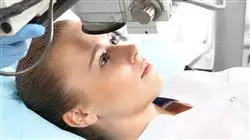University certificate
The world's largest faculty of medicine”
Introduction to the Program
The latest advances in the area of Optical Technologies and Clinical Optometry compiled in a highly efficient Professional master’s degree that will optimize your effort with the best results

Continuous specialization in the latest optometric technologies and treatments is essential in professional updating, preparing to take on jobs that are increasingly integrated into the healthcare system, both public and private.
The Professional master’s degree in Optical Technologies and Clinical Optometry covers the main fields of action of the optometrist, always in the most up-to-date manner and with a high-level faculty. The syllabus has been designed from the perspective and experience of experts highly specialized in their module, and immersed in the clinical world, which has led to know the current and future challenges.
This Professional master’s degree has been clearly and forcefully directed to the clinical field, preparing the student to develop in this field with extensive theoretical knowledge. Thus, you will learn how to make special adaptations of contact lenses, know the preoperative tests for cataract surgery, the basics of biostatistics especially aimed at research in optics and optometry, in-depth understanding of the treatment of low vision from clinical practice, pediatric optometry, introduce you to vision therapy with a practical and interdisciplinary approach, the latest advances in instrumentation and treatment of amblyopia, and other interesting and useful fields of optometric performance.
The student will have 13 modules, each of them structured in 10 topics. Each topic consists of a theoretical introduction, explanations by the professor, activities, etc. In such a way that learning becomes an enjoyable journey to high-level knowledge in Optical Instrumentation and Clinical Optometry.
In conclusion, this Professional Master's Degree provides the professional with the theoretical and clinical knowledge necessary to address any of the specialties of Optics and Optometry, as well as opening the door to clinical research.
This Professional master’s degree in Optical Technologies and Clinical Optometry will help you keep up to date in order to provide complete and quality care to patients”
This Professional master’s degree in Optical Technologies and Clinical Optometry contains the most complete and up-to-date program on the market. The most important features of the program include:
- More than 100 clinical cases presented by experts in the different specialities
- The graphic, schematic, and eminently practical contents with which they are created, provide scientific and practical information on the disciplines that are essential for professional practice.
- The most frequent new developments in Optical Technologies and Clinical Optometry
- The presentation of hands-on workshops on procedures, diagnostic and therapeutic techniques
- An algorithm-based interactive learning system for decision-making in the clinical situations presented throughout the course.
- Theoretical lessons, questions to the expert, debate forums on controversial topics, and individual reflection assignments
- Content that is accessible from any fixed or portable device with an Internet connection
This Professional master’s degree is the best investment you can make when choosing a refresher program to update your existing knowledge of Optical Technologies and Clinical Optometry”
The teaching staff includes professionals from the field of Optical Technologies and Clinical Optometry, who bring their experience to this training program, as well as renowned specialists from leading societies and prestigious universities.
The multimedia content, developed with the latest educational technology, will provide the professional with situated and contextual learning, i.e., a simulated environment that will provide an immersive training experience designed to train for real-life situations.
This program is designed around Problem Based Learning, where the Optometry professional must try to solve the different professional practice situations that arise during the course. For this purpose, the specialist will be assisted by an innovative interactive video system created by renowned and experienced experts in treating patients in children with extensive experience.
All of the methodology necessary for the optometrist to achieve academic excellence, in a specific and concrete Professional master’s degree”

We have the best didactic material, an innovative methodology and a 100% online training, which will facilitate your study”
Why study at TECH?
TECH is the world’s largest online university. With an impressive catalog of more than 14,000 university programs available in 11 languages, it is positioned as a leader in employability, with a 99% job placement rate. In addition, it relies on an enormous faculty of more than 6,000 professors of the highest international renown.

Study at the world's largest online university and guarantee your professional success. The future starts at TECH”
The world’s best online university according to FORBES
The prestigious Forbes magazine, specialized in business and finance, has highlighted TECH as “the world's best online university” This is what they have recently stated in an article in their digital edition in which they echo the success story of this institution, “thanks to the academic offer it provides, the selection of its teaching staff, and an innovative learning method aimed at educating the professionals of the future”
A revolutionary study method, a cutting-edge faculty and a practical focus: the key to TECH's success.
The most complete study plans on the university scene
TECH offers the most complete study plans on the university scene, with syllabuses that cover fundamental concepts and, at the same time, the main scientific advances in their specific scientific areas. In addition, these programs are continuously being updated to guarantee students the academic vanguard and the most in-demand professional skills. In this way, the university's qualifications provide its graduates with a significant advantage to propel their careers to success.
TECH offers the most comprehensive and intensive study plans on the current university scene.
A world-class teaching staff
TECH's teaching staff is made up of more than 6,000 professors with the highest international recognition. Professors, researchers and top executives of multinational companies, including Isaiah Covington, performance coach of the Boston Celtics; Magda Romanska, principal investigator at Harvard MetaLAB; Ignacio Wistumba, chairman of the department of translational molecular pathology at MD Anderson Cancer Center; and D.W. Pine, creative director of TIME magazine, among others.
Internationally renowned experts, specialized in different branches of Health, Technology, Communication and Business, form part of the TECH faculty.
A unique learning method
TECH is the first university to use Relearning in all its programs. It is the best online learning methodology, accredited with international teaching quality certifications, provided by prestigious educational agencies. In addition, this disruptive educational model is complemented with the “Case Method”, thereby setting up a unique online teaching strategy. Innovative teaching resources are also implemented, including detailed videos, infographics and interactive summaries.
TECH combines Relearning and the Case Method in all its university programs to guarantee excellent theoretical and practical learning, studying whenever and wherever you want.
The world's largest online university
TECH is the world’s largest online university. We are the largest educational institution, with the best and widest online educational catalog, one hundred percent online and covering the vast majority of areas of knowledge. We offer a large selection of our own degrees and accredited online undergraduate and postgraduate degrees. In total, more than 14,000 university degrees, in eleven different languages, make us the largest educational largest in the world.
TECH has the world's most extensive catalog of academic and official programs, available in more than 11 languages.
Google Premier Partner
The American technology giant has awarded TECH the Google Google Premier Partner badge. This award, which is only available to 3% of the world's companies, highlights the efficient, flexible and tailored experience that this university provides to students. The recognition as a Google Premier Partner not only accredits the maximum rigor, performance and investment in TECH's digital infrastructures, but also places this university as one of the world's leading technology companies.
Google has positioned TECH in the top 3% of the world's most important technology companies by awarding it its Google Premier Partner badge.
The official online university of the NBA
TECH is the official online university of the NBA. Thanks to our agreement with the biggest league in basketball, we offer our students exclusive university programs, as well as a wide variety of educational resources focused on the business of the league and other areas of the sports industry. Each program is made up of a uniquely designed syllabus and features exceptional guest hosts: professionals with a distinguished sports background who will offer their expertise on the most relevant topics.
TECH has been selected by the NBA, the world's top basketball league, as its official online university.
The top-rated university by its students
Students have positioned TECH as the world's top-rated university on the main review websites, with a highest rating of 4.9 out of 5, obtained from more than 1,000 reviews. These results consolidate TECH as the benchmark university institution at an international level, reflecting the excellence and positive impact of its educational model.” reflecting the excellence and positive impact of its educational model.”
TECH is the world’s top-rated university by its students.
Leaders in employability
TECH has managed to become the leading university in employability. 99% of its students obtain jobs in the academic field they have studied, within one year of completing any of the university's programs. A similar number achieve immediate career enhancement. All this thanks to a study methodology that bases its effectiveness on the acquisition of practical skills, which are absolutely necessary for professional development.
99% of TECH graduates find a job within a year of completing their studies.
Professional Master's Degree in Optical Technologies and Clinical Optometry
In matters of visual health, being at the forefront of knowledge and handling of tools is the only way for the optometrist to achieve a quality praxis and excel in the labor market. As refractive eye defects such as myopia and astigmatism become more and more frequent in the population, the need for professionals who can evaluate and correct such conditions increases. Seeking to update and expand skills in the discipline, TECH offers the Professional Master's Degree in Optical Technologies and Clinical Optometry: a one-year postgraduate course taught in a 100% online format where students can manage their own learning time and access rigorous study material. In this simulated digital environment you will find the latest in scientific concepts and interactive practice covering several thematic blocks: optometric procedures in corneal, intraocular and cataract refractive surgery, biostatistics for research in optics and optometry, vision therapy in clinical practice, among others. If you are looking for an ally in your professional growth, TECH is the perfect choice.
Get your degree in clinical optometry and optical technologies.
It seems incredible, but the WHO data are irrefutable: people are seeing less and less. About 15% of the world's population suffers from myopia and it is estimated that in the next three decades the number may increase up to 50% if corrective actions are not taken. This Professional Master's Degree is an ideal way to take the first step towards that goal of gradually reducing eye problems. A pair of glasses can save the future. Conceived in ten detailed modules through multiple thematic units, this training will help you add knowledge in: ocular biometry and intraocular lens calculation, visual therapy in amblyopia and strabismus, clinically significant optical aberrations, geriatric and pediatric optometry, anesthetic drugs in ophthalmology, techniques in optic nerve, retina, choroid, anterior chamber and iridocorneal angle evaluation, etc. In comfortable, self-regulated classes that you can combine with other activities and guided by an excellent teaching staff, we will boost your career so that you can clearly see your professional success.







